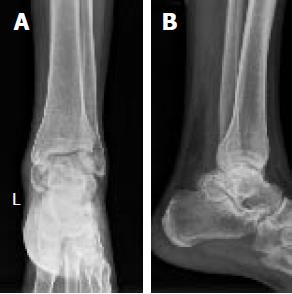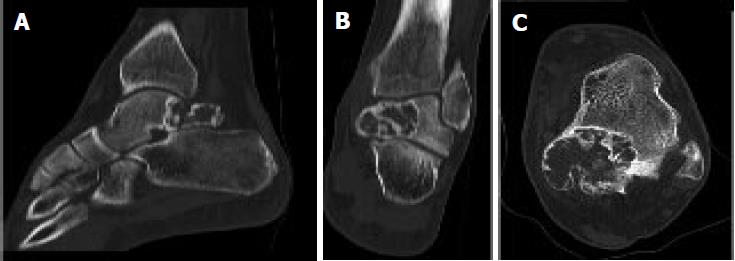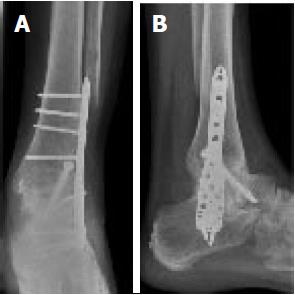Published online Sep 16, 2017. doi: 10.12998/wjcc.v5.i9.364
Peer-review started: February 12, 2017
First decision: March 28, 2017
Revised: June 23, 2017
Accepted: July 7, 2017
Article in press: July 10, 2017
Published online: September 16, 2017
Processing time: 232 Days and 23 Hours
Aneurysmal bone cyst (ABC), a locally benign aggressive lytic lesion of either primary or secondary origin, seldom involves the talus. Herein, we present a 25-year-old man with recurrent ABC of the talus after curettage and bone grafting, which was managed by total resection followed by filling the defect using fibular graft and finally tibiotalocalcaneal arthrodesis due to articular surface involvement. At 18 mo postoperatively, no recurrence was detected. Arthrodesis might be a good option in cases with recurrent ABC of the talus especially with articular surface involvement.
Core tip: Despite rarity of aneurysmal bone cyst (ABC) of the talus, we present a case of recurrent ABC of the talus following curettage and bone graft. The tibiotalar and subtalar joints of the patient were fused after complete resection of the tumor.
- Citation: Vosoughi AR, Mozaffarian K, Erfani MA. Recurrent aneurysmal bone cyst of talus resulted in tibiotalocalcaneal arthrodesis. World J Clin Cases 2017; 5(9): 364-367
- URL: https://www.wjgnet.com/2307-8960/full/v5/i9/364.htm
- DOI: https://dx.doi.org/10.12998/wjcc.v5.i9.364
Aneurysmal bone cyst (ABC) is a benign aggressive bone lesion composed of expansible blood-filled cavities. The incidence is 0.14 per 100000 of the population per year with a slight female predominance[1]. Although all parts of human skeleton can be involved, ABC of foot bones and particularly the talus is very rare[2,3]. Several primary ABCs of the talus[2,4-6] and secondary ABCs on giant cell tumor[7] and Chondroblastoma[8] were described in the literature. Recurrence of ABC of the talus after curettage and bone grafting is extremely rare[5,6]. Surgical treatment of these lesions is essential to reduce the pain of the patient and to prevent the possibility of pathologic fracture. In the present case, we describe a case of recurrent ABC talus with articular surface involvement which resulted in tibiotalocalcaneal arthrodesis.
A 25-year-old man presented with swelling and pain in left ankle joint without any history of acute trauma. He had experienced another episode of severe swelling and pain in left ankle area without any preceding trauma about 2 years before arrival. After definite diagnosis of ABC by another surgeon in another hospital, He had undergone curettage and autologous bone grafting via medial ankle approach and detachment of deltoid ligament.
Eight months after previous surgery, pain and swelling had begun again and continued till the time of second operation. On examination, swelling and tenderness on medial side was clearly evident. The neurovascular status of left ankle and foot was intact. Range of motion of ankle was limited to 25 degrees in plantar flexion and 10 degrees in dorsiflexion in comparison to the right ankle. Moreover it was painful particularly in full plantar flexion. Left ankle plain radiograph showed a cystic lesion in posteromedial of left talus with invasion to the articular surface of tibiotalar and subtalar joints (Figure 1). As ankle CT scan clearly approved the size and intra-articular invasion of the lesion (Figure 2), magnetic resonance imaging was not requested.
Surgery was performed under general anesthesia in the lateral position after inflation of a thigh tourniquet using sterile conditions. Through direct lateral approach to the lateral malleolus, fibular osteotomy from 10 cm above tip of fibula was done and completely resected. The articular surfaces of tibiotalar and subtalar joints were removed. The ABC was carefully resected because of adhesions to the posteromedial structure of the ankle joint. The pathologic report confirmed recurrent ABC. After curettage, the bone graft from the excised distal fibula bone was impacted in the arthrodesis site. The correct position of tibiotalar and subtalar joints for fusion was prepared and fixed by a Steinmann wire temporarily. Finally, the fixation was achieved utilizing a compression screw and a PHILOS plate on lateral side from calcaneus to the distal of tibia. Short leg cast was applied till complete union at 3 mo postoperatively.
Follow-up imaging at 18 mo after the operation showed no apparent sign of recurrence (Figure 3). The patient has a little claudication due to triceps surae weakness. He also suffers from occasional pain after long-distance walking.
ABC is a benign tumoral condition peaking at the first two decades of life[1]. Although different treatment options are available, commonly surgical treatment of ABCs including curettage with or without bone grafting in addition to different adjuvants or wide en-bloc resection of tumor is preferred[6,9-11]. Although the presented case was initially treated using curettage and bone grafting, recurrence was seen after 8 mo following the primary surgery. Recurrence is not uncommon and the reported rates are as high as 59%[12]. Local recurrence is particularly higher among young age male patients[13].
On the other hand, wide en-bloc excision is an excellent option with the lowest rates of recurrence (95%-100% localized control)[14]. Moreover, it leads to reduce risk of future malignant transformations. Complete resection should be limited to expandable bones like distal ulna or proximal fibula. Complete resection in the other parts is associated with high morbidity to the patient. Resection of a huge ABC with involvement of articular surfaces in the talus could result in instability and functional compromise; therefore arthrodesis might be an acceptable option to diminish the possibility of recurrence, as done in the presented case.
Tibiotalocalcaneal arthrodesis could be done utilizing retrograde hindfoot intramedullary nails or different plate and screw constructs. Although intramedullary nails are good options with higher stability and lower soft tissue damage[15], we prefer to use plate with screws because of more access to the lesion from lateral approach and surgeon experience for this technique.
This case approved that despite rarity of ABC in the talus, recurrence of ABC of the talus with articular surface involvement after curettage and bone grafting could be treated by en-bloc resection and consequent arthrodesis.
A 25-year-old male presented to the authors’ outpatient clinic with swelling and pain in left ankle joint with positive history of aneurysmal bone cyst (ABC) of the talus.
Recurrent ABC of the talus.
Unicameral bone cyst, bone malignancies.
Plain radiograph and computed tomography demonstrated a big cystic lesion in posteromedial of left talus with invasion to surrounding articular surfaces.
The histopathology report confirmed recurrence of ABC of the talus.
Complete resection followed by bone grafting and tibiotalocalcaneal arthrodesis.
There have been very rare case reports of recurrent ABC of the talus treated using arthrodesis methods.
PHILOS plate is an anatomical locking compression plating system for proximal humerus fracture fixation.
Early definite treatment of massive bone cysts in hindfoot is strongly encouraged to prevent inadvertent complications like pathologic fractures.
This is an interesting case report.
Manuscript source: Invited manuscript
Specialty type: Medicine, research and experimental
Country of origin: Iran
Peer-review report classification
Grade A (Excellent): 0
Grade B (Very good): B
Grade C (Good): C, C
Grade D (Fair): 0
Grade E (Poor): 0
P- Reviewer: Huang SP, Singer G, Wu CC S- Editor: Ji FF L- Editor: A E- Editor: Zhao LM
| 1. | Mascard E, Gomez-Brouchet A, Lambot K. Bone cysts: unicameral and aneurysmal bone cyst. Orthop Traumatol Surg Res. 2015;101:S119-S127. [RCA] [PubMed] [DOI] [Full Text] [Cited by in Crossref: 125] [Cited by in RCA: 154] [Article Influence: 15.4] [Reference Citation Analysis (0)] |
| 2. | Sharma S, Gupta P, Sharma S, Singh M, Singh D. Primary aneurysmal bone cyst of talus. J Res Med Sci. 2012;17:1192-1194. [PubMed] |
| 3. | Jeon JY, Chung HW, Kwon JW, Hong SH, Lee GY, Ryu KN. Imaging findings of various talus bone tumors-clinico-radiologic features of talus bone tumors. Clin Imaging. 2016;40:666-677. [RCA] [PubMed] [DOI] [Full Text] [Cited by in Crossref: 4] [Cited by in RCA: 4] [Article Influence: 0.4] [Reference Citation Analysis (0)] |
| 4. | El Shazly O, Abou El Soud MM, Nasef Abdelatif NM. Arthroscopic intralesional curettage for large benign talar dome cysts. SICOT J. 2015;1:32. [RCA] [PubMed] [DOI] [Full Text] [Full Text (PDF)] [Cited by in Crossref: 7] [Cited by in RCA: 9] [Article Influence: 0.9] [Reference Citation Analysis (0)] |
| 5. | El-Moatasem el-HM, Abdel-Rahman M, Eid MA. Extended curettage and adjuvant therapy for benign tumors of the talus. Foot (Edinb). 2015;25:79-83. [RCA] [PubMed] [DOI] [Full Text] [Cited by in Crossref: 9] [Cited by in RCA: 12] [Article Influence: 1.2] [Reference Citation Analysis (0)] |
| 6. | Özer D, Er T, Aycan OE, Öke R, Coşkun M, Kabukçuoğlu YS. May bone cement be used to treat benign aggressive bone tumors of the feet with confidence? Foot (Edinb). 2014;24:1-5. [RCA] [PubMed] [DOI] [Full Text] [Cited by in Crossref: 5] [Cited by in RCA: 8] [Article Influence: 0.7] [Reference Citation Analysis (0)] |
| 7. | Kinley S, Wiseman F, Wertheimer SJ. Giant cell tumor of the talus with secondary aneurysmal bone cyst. J Foot Ankle Surg. 1993;32:38-46. [PubMed] |
| 8. | Sun B, Li XY, Zhao XY, Feng Wei, Liu JG. [Chondroblastoma with associated aneurysmal bone cyst of the talus: a case report and review of relative literatures]. Zhongguo Gu Shang. 2015;28:657-659. [PubMed] |
| 9. | Solooki S, Keikha Y, Vosoughi AR. Can ethanol be used as an adjuvant to extended curettage in order to reduce the recurrence rate of aneurysmal bone cyst? Rev Bras Ortop. 2017;52:349-353. [RCA] [DOI] [Full Text] [Full Text (PDF)] [Cited by in Crossref: 2] [Cited by in RCA: 6] [Article Influence: 0.8] [Reference Citation Analysis (0)] |
| 10. | Lin PP, Brown C, Raymond AK, Deavers MT, Yasko AW. Aneurysmal bone cysts recur at juxtaphyseal locations in skeletally immature patients. Clin Orthop Relat Res. 2008;466:722-728. [RCA] [PubMed] [DOI] [Full Text] [Cited by in Crossref: 42] [Cited by in RCA: 46] [Article Influence: 2.7] [Reference Citation Analysis (0)] |
| 11. | Park HY, Yang SK, Sheppard WL, Hegde V, Zoller SD, Nelson SD, Federman N, Bernthal NM. Current management of aneurysmal bone cysts. Curr Rev Musculoskelet Med. 2016;9:435-444. [RCA] [PubMed] [DOI] [Full Text] [Cited by in Crossref: 99] [Cited by in RCA: 135] [Article Influence: 15.0] [Reference Citation Analysis (0)] |
| 12. | Biesecker JL, Marcove RC, Huvos AG, Miké V. Aneurysmal bone cysts. A clinicopathologic study of 66 cases. Cancer. 1970;26:615-625. [PubMed] |
| 13. | Zehetgruber H, Bittner B, Gruber D, Krepler P, Trieb K, Kotz R, Dominkus M. Prevalence of aneurysmal and solitary bone cysts in young patients. Clin Orthop Relat Res. 2005;439:136-143. [PubMed] |
| 14. | Mostafa MF. Subperiosteal resection of fibular aneurysmal bone cyst. Eur J Orthop Surg Traumatol. 2015;25:443-450. [RCA] [PubMed] [DOI] [Full Text] [Cited by in Crossref: 6] [Cited by in RCA: 11] [Article Influence: 1.0] [Reference Citation Analysis (0)] |
| 15. | Burns PR, Dunse A. Tibiotalocalcaneal Arthrodesis for Foot and Ankle Deformities. Clin Podiatr Med Surg. 2017;34:357-380. [RCA] [PubMed] [DOI] [Full Text] [Cited by in Crossref: 11] [Cited by in RCA: 13] [Article Influence: 1.6] [Reference Citation Analysis (0)] |











